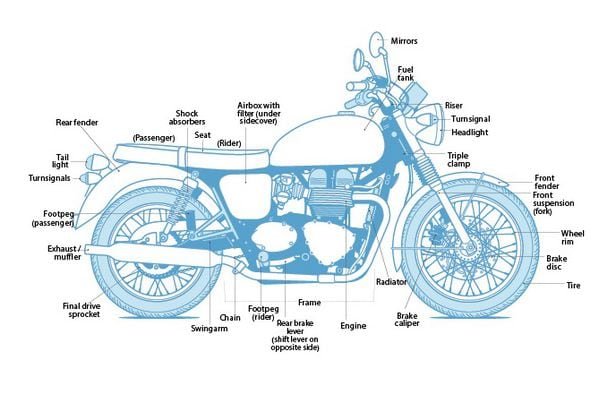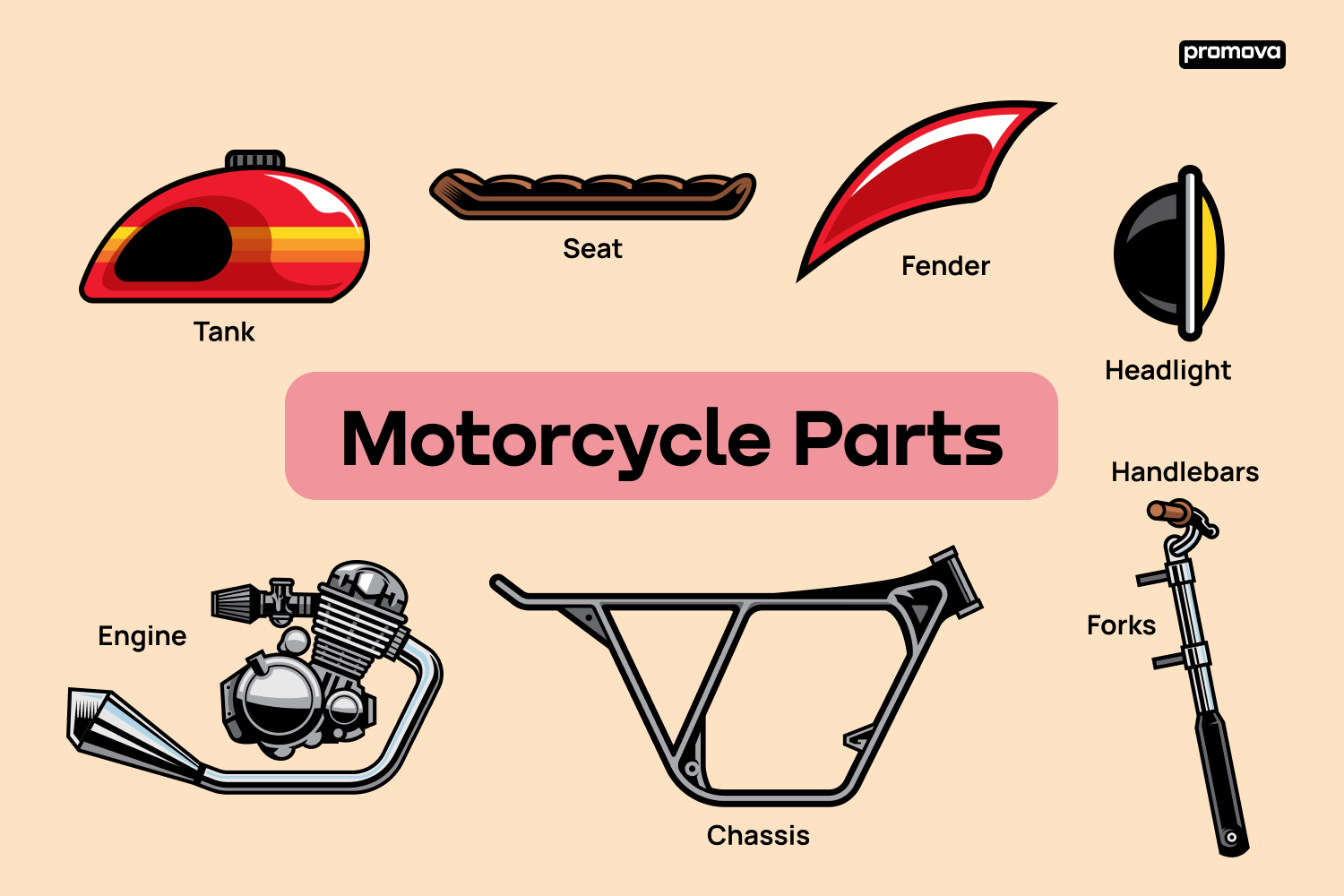Pro Tips About Choosing Quality Motorcycle Parts Auckland
A Comprehensive Guide to Choosing the most effective Bike Components for Your Experience
Picking the right bike components is essential for any cyclist. Each part plays a considerable function in boosting efficiency and comfort. Understanding the kind of bike and its designated usage is basic. From handlebars to tires, every detail issues. This guide will discover the crucial aspects of selecting these parts. The ideal selections can raise any type of experience, but what particular factors should one think about to attain the very best outcomes?
Understanding Bike Types and Their Parts
Exactly how can one pick the appropriate bike parts without recognizing the various sorts of bikes? Each bike type-- hill, roadway, crossbreed, and cruiser-- attributes special parts customized to its certain feature. Mountain bicycle, as an example, are furnished with robust structures and larger tires for off-road security, while roadway bikes focus on lightweight products and wind resistant styles for rate on smooth surfaces.Hybrids mix aspects from both mountain and road bikes, providing adaptability for diverse terrains. Cruisers, made for convenience, attribute bigger seats and handlebars for an extra relaxed riding placement. Each kind also uses distinct equipment systems, brakes, and wheels that accommodate their designated use.Understanding these differences is crucial for picking reliable and suitable bike components. A rider's option can significantly enhance performance, safety, and general satisfaction. By recognizing the characteristics of each bike type, one can make enlightened choices when updating or replacing elements.
Key Factors To Consider for Choosing Handlebars
When picking handlebars, a biker must consider various elements that can greatly influence comfort and control. One key factor to consider is the width of the handlebars, as it affects security and utilize during trips. Broader handlebars normally provide far better control, particularly in technological surfaces, while narrower ones may boost the rules of aerodynamics for racing.Additionally, the increase or decline of the handlebars influences the cyclist's stance. Higher handlebars promote a more upright placement, reducing strain on the back, while lower ones can boost aerodynamics. The shape of the handlebars is likewise essential; alternatives like level, riser, or drop bars cater to various riding designs and preferences.Material is one more crucial element, with aluminum and carbon fiber being preferred for their equilibrium of weight and longevity. Ultimately, the appropriate handlebars need to align with the rider's planned use, guaranteeing a enjoyable and effective cycling experience.
Choosing the Right Saddle for Comfort and Performance
Picking the appropriate saddle is essential for optimizing convenience and efficiency during adventures. An appropriate saddle can greatly affect a bicyclist's experience, directly influencing energy degrees and total satisfaction. When choosing a saddle, elements such as form, width, and padding ought to be carefully thought about. The saddle's size should straighten with the motorcyclist's sit bone measurements, ensuring appropriate support. In addition, extra padding preferences differ among cyclists; some may favor very little cushioning for an extra direct connection to the bike, while others may look for deluxe cushioning for improved convenience on longer rides. Saddle form also plays an essential function, as it impacts the circulation of stress throughout pedaling. Moreover, materials utilized in building can influence weight and longevity. Eventually, checking various saddles is essential, as personal convenience differs considerably. A thoughtful method to saddle choice can bring about better efficiency and an extra satisfying biking experience.
The Significance of High Quality Tires for Various Terrains
Picking the right tires is important for excellent efficiency across numerous terrains. Different surfaces require particular tire functions, such as tread patterns and rubber compounds, to guarantee traction and toughness. Furthermore, the durability and durability of tires can substantially influence a bicyclist's general experience and safety and security on the road or path.

Terrain-Specific Tire Includes
Exactly how does the terrain effect tire efficiency? Different terrains call for distinct tire functions to optimize performance and security. As an example, hill cycling on rocky trails demands tires with aggressive tread patterns to provide hold and stability. On the other hand, roadway cycling on smooth surfaces benefits from narrower tires that decrease rolling resistance.In damp or muddy problems, tires made with much deeper grooves can transport water properly, preventing hydroplaning. Additionally, softer compounds might boost grip on glossy surfaces, while harder substances provide longevity on rough courses. Comprehending these terrain-specific tire functions is important for bicyclists intending to boost their riding experience. Selecting the ideal tire not just influences handling however additionally general comfort, making it vital for motorcyclists to match their tires to their desired terrain.
Tire Longevity and Performance
Quality tires significantly affect a biker's efficiency and safety and security throughout various surfaces. The longevity of tires is crucial for withstanding the roughness of different surface areas, from sturdy trails to smooth roadways. Better tires often include enhanced sidewalls and advanced rubber substances, which improve their long life and grip. Tires developed for off-road conditions normally possess deeper footsteps that provide better traction on loose surface areas, while roadway tires prioritize a smoother profile for reduced rolling resistance. In wet conditions, tires with specialized walk patterns can improve handling and decrease the danger of hydroplaning. Inevitably, investing in quality tires customized to specific riding atmospheres can considerably improve overall biking experience, guaranteeing both efficiency and safety.
Gearing Solutions: Finding the Perfect Suitable For Your Riding Style
While several cyclists recognize the importance of a good bike frame or wheels, the gearing system plays an essential duty in boosting efficiency and convenience on the road or path. Choosing the appropriate tailoring system depends largely on individual riding design and surface. Roadway cyclists usually profit from a portable see page gearing setup, enabling for smoother shifts and higher rates on level surface areas. In contrast, hill bicycle riders might like a bigger range of gears to tackle steep climbs and harsh descents.Cyclists must likewise consider the number of equipments; a 1x system streamlines shifting and minimizes weight, while a 2x or 3x system uses convenience for different surfaces. Understanding equipment proportions is important, as reduced proportions help with easier pedaling uphill, while greater proportions support speed on level stretches. Inevitably, the best gearing system harmonizes with the cyclist's preferences, making sure a enjoyable and effective biking experience.
Enhancing Your Adventure With the Right Brakes
Selecting the suitable braking system is as essential as choosing the appropriate gearing for a bike. The high quality and kind of brakes can noticeably affect a biker's control, safety and security, and overall riding experience. Cyclists usually encounter an option between edge brakes and disc brakes. Rim brakes are generally lighter and much easier to preserve, making them a preferred choice for road bikes, while disc brakes supply premium quiting power and efficiency in different climate condition, suitable for mountain bicycle and visiting setups.Moreover, brake pads play an essential duty in braking performance. Choosing the best product-- such as natural, metal, or semi-metallic-- can enhance efficiency based on riding conditions and individual preferences. Additionally, correct positioning and routine upkeep of the stopping system warranty trustworthy efficiency and long life. Ultimately, buying the ideal brakes tailored to specific riding designs can boost safety and security and enjoyment on every trip.
Upgrading Accessories for a Better Biking Experience
Updating devices can greatly improve a bicyclist's experience when traveling. Crucial safety equipment, such as lights and safety helmets, combined with convenience enhancements like padded seats and ergonomic holds, can make a notable difference. These upgrades not just improve safety however additionally promote longer and more satisfying experiences.
Essential Security Equipment
Security equipment is an essential component of a cyclist's arsenal, improving both protection and comfort when driving. Helmets are one of the most important item, greatly reducing the risk of head injuries in situation of a crash. High-visibility clothes and devices, such as reflective vests and lights, assure that cyclists stay visible to motorists, especially in low-light problems. Handwear covers offer grasp and lower the probability of blisters, while knee and elbow pads can supply added security during falls. Picking proper shoes with an excellent hold can likewise improve safety while biking. Investing in quality safety equipment not just promotes a much safer ride yet also increases a cyclist's self-confidence, allowing them to appreciate their biking experience to the greatest.
Convenience Enhancements and Upgrades
Cyclists typically seek to enhance their riding experience past basic precaution. Convenience improvements and upgrades play a crucial function in attaining this goal. One of the most considerable upgrades is a top notch saddle, developed to supply maximum assistance and minimize discomfort throughout longer experiences. On top of that, handlebar grasps that offer better functional designs can ease pressure on wrists and hands. Investing in cushioned biking shorts can furthermore enhance convenience by decreasing friction and pressure factors. Moreover, shock-absorbing seat posts and larger tires can boost adventure top quality by wetting resonances from rough terrain - Bike Parts Wellington. Lastly, adjusting the bike fit assurances that placements are perfect for specific bikers, leading to a much more pleasurable and comfy cycling experience
Often Asked Concerns
How Do I Keep My Bike Components for Longevity?
Maintaining bike parts for longevity entails routine cleansing, lubrication, and inspection. Correct storage space away from dampness, timely published here replacement of worn elements, and adherence to supplier standards can substantially boost the lifespan and efficiency of the bicycle.
What Tools Do I Required for Bike Component Installment?
To set up bike components properly, one normally calls for crucial tools such as wrenches, screwdrivers, tire bars, a multi-tool, and a pump. These instruments facilitate appropriate assembly, guaranteeing optimal performance and durability of the bike elements.
How Often Should I Replace Bike Elements?

Can I Mix and Match Components From Different Brands?
Matching and blending bike parts from various brands is feasible, however compatibility is important (Oem Parts New Zealand). Aspects like dimensions, materials, and layout should be taken into consideration to guarantee peak efficiency and safety, highlighting the importance of study before any type of mix
What Are the Signs of Worn-Out Bike Parts?
Signs of damaged bike components include uncommon noises during rides, decreased performance, noticeable damage such as fractures or corrosion, and difficulty shifting equipments. Normal assessments can assist identify these concerns prior to they endanger safety and efficiency. Mountain bikes, for circumstances, are outfitted with durable frames and wider tires for off-road stability, while roadway bikes focus on light-weight materials and wind resistant layouts for speed on paved surfaces.Hybrids mix components from both mountain and road bikes, using flexibility for diverse terrains. On the other hand, roadway biking on smooth surfaces benefits from narrower tires that minimize rolling resistance.In wet or sloppy conditions, tires developed with much deeper grooves can direct water properly, avoiding hydroplaning. Comprehending these terrain-specific tire functions is essential for cyclists intending to enhance their riding experience. Tires developed for off-road problems normally possess deeper treads that supply far better grip on loosened surface areas, while road continue reading this tires focus on a smoother account for lowered rolling resistance. To install bike parts efficiently, one generally requires important devices such as wrenches, screwdrivers, tire bars, a multi-tool, and a pump.